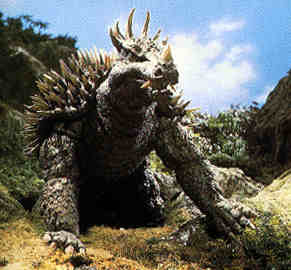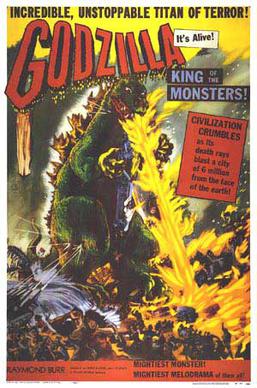
Godzilla is a fictional monster, or kaiju, that debuted in the eponymous 1954 film, directed and cowritten by Ishirō Honda. The character has since become an international pop culture icon, appearing in various media: 33 Japanese films produced by Toho Co., Ltd., five American films, and numerous video games, novels, comic books, and television shows. Godzilla has been dubbed the "King of the Monsters", an epithet first used in Godzilla, King of the Monsters! (1956), the American localization of the 1954 film.

Godzilla vs. Megalon is a 1973 Japanese kaiju film directed by Jun Fukuda, written by Fukuda and Shinichi Sekizawa, and produced by Tomoyuki Tanaka, with special effects by Teruyoshi Nakano. Distributed by Toho and produced under their effects subsidiary Toho–Eizo, it is the 13th film in the Godzilla franchise, and features the fictional monster characters Godzilla, Megalon, and Gigan, along with the mecha character Jet Jaguar. The film stars Katsuhiko Sasaki, Hiroyuki Kawase, Yutaka Hayashi, and Robert Dunham, alongside Shinji Takagi as Godzilla, Hideto Date as Megalon, Kenpachiro Satsuma as Gigan, and Tsugutoshi Komada as Jet Jaguar.

The Return of Godzilla is a 1984 Japanese kaiju film directed by Koji Hashimoto, with special effects by Teruyoshi Nakano. The film features the fictional monster character Godzilla. Distributed by Toho and produced under their subsidiary Toho Pictures, it is the 16th film in the Godzilla franchise, the last film produced in the Shōwa era, and the first film in the Heisei series. In Japan, the film was followed by Godzilla vs. Biollante in 1989.

Kaiju is a Japanese term that is commonly associated with media involving giant monsters. A subgenre of science fiction, it was created by Eiji Tsuburaya and Ishirō Honda. The term can also refer to the giant monsters themselves, which are usually depicted attacking major cities and battling either the military or other monsters.

Rodan is a fictional monster, or kaiju, which first appeared as the title character in Ishirō Honda's 1956 film Rodan, produced and distributed by Toho. Following its debut standalone appearance, Rodan went on to be featured in numerous entries in the Godzilla franchise, including Ghidorah, the Three-Headed Monster, Invasion of Astro-Monster, Destroy All Monsters, Godzilla vs. Mechagodzilla II and Godzilla: Final Wars, as well as in the Legendary Pictures-produced film Godzilla: King of the Monsters.
Industrial Light & Magic (ILM) is an American motion picture visual effects company that was founded on May 26, 1975 by George Lucas. It is a division of the film production company Lucasfilm, which Lucas founded, and was created when he began production on the original Star Wars, now the fourth episode of the Skywalker Saga.

Mothra is a fictional monster, or kaiju, that first appeared in the 1961 film Mothra, produced and distributed by Toho Studios. Mothra has appeared in several Toho tokusatsu films, most often as a recurring monster in the Godzilla franchise. She is typically portrayed as a colossal sentient larva (caterpillar) or imago, accompanied by two miniature fairies speaking on her behalf. Unlike other Toho monsters, Mothra is a largely heroic character, having been variously portrayed as a protector of her own island culture, the Earth and Japan. Mothra's design is influenced by silk worms, their imagos, and those of giant silk moths in the family Saturniidae. The character is often depicted hatching offspring when approaching death, a nod to the Saṃsāra doctrine of numerous Indian religions.

Anguirus is a fictional monster, or kaiju, which first appeared in Godzilla Raids Again (1955), the second film in the Godzilla franchise. Anguirus is the first monster to be shown engaging in combat with Godzilla in a film. Since then, the character has appeared conversely as an enemy and an ally of Godzilla in numerous films produced by Toho, including Destroy All Monsters, Godzilla vs. Gigan, Godzilla vs. Megalon, Godzilla vs. Mechagodzilla, and Godzilla: Final Wars. He has also appeared in other media, including comic books and video games.

King Ghidorah is a fictional monster, or kaiju, which first appeared in Ishirō Honda's 1964 film Ghidorah, the Three-Headed Monster. The monster was initially created by Tomoyuki Tanaka, Eiji Tsuburaya and Shinichi Sekizawa as an homage to the eight-headed mythological Japanese dragon Yamata no Orochi. Although the name of the character is officially trademarked by Toho as "King Ghidorah", the character was originally referred to as Ghidorah or Ghidrah in some English markets.

Mothra vs. Godzilla is a 1964 Japanese kaiju film directed by Ishirō Honda, with special effects by Eiji Tsuburaya. Produced and distributed by Toho Co., Ltd., it is the fourth film in the Godzilla franchise. The film stars Akira Takarada, Yuriko Hoshi, Hiroshi Koizumi, Kenji Sahara, and Emi and Yumi Itō, with Haruo Nakajima and Katsumi Tezuka as Godzilla. In the film, humans beseech the aid of the insect god Mothra to stop Godzilla from destroying Japan.

Zilla is a fictional monster, or kaiju, in Toho Co., Ltd.'s Godzilla media franchise. The character first appeared in Godzilla (1998), released by TriStar Pictures. It was initially created as a reimagining of Godzilla but was later re-branded as a separate character. Patrick Tatopoulos designed it after iguanas with a slim theropod appearance rather than the thick, bipedal designs of Toho's Godzilla. TriStar's Godzilla, both the film and character, were negatively received by fans and critics. In 2004, it was featured in Toho's Godzilla: Final Wars as "Zilla". Afterwards, Toho trademarked new incarnations as Zilla, with only the iterations from the 1998 film and animated series retaining the Godzilla copyright and trademark.
Godzilla has appeared in a range of comic books that have been published in Japan and the United States.

Varan is a fictional monster, or kaiju, that first appeared in the 1958 film Giant Monster Varan, directed by Ishirō Honda and produced and distributed by Toho. Varan is depicted as a giant prehistoric reptile capable of gliding flight, and has gone on to appear in the 1968 film Destroy All Monsters, the ninth film in the Godzilla franchise.

Godzilla, King of the Monsters! is a 1956 kaiju film directed by Terry O. Morse and Ishirō Honda, with special effects by Eiji Tsuburaya. It is a heavily re-edited American localization, or "Americanization", of the 1954 Japanese film Godzilla. The film was a Japanese-American co-production, with the original footage produced by Toho Co., Ltd., and the new footage produced by Jewell Enterprises. The film stars Raymond Burr, Takashi Shimura, Momoko Kōchi, Akira Takarada, and Akihiko Hirata, with Haruo Nakajima and Katsumi Tezuka as Godzilla. In the film, an American reporter covers a giant reptilian monster's attack on Japan.

SpaceGodzilla is a Godzilla clone kaiju that first appeared in Toho's 1994 film Godzilla vs. SpaceGodzilla, as the main antagonist.

Godzilla is a Japanese monster, or kaiju, media franchise consisting of films, television series, novels, comic books, video games, and other merchandise. The franchise is centered on the fictional kaiju Godzilla, a prehistoric reptilian monster awakened and powered by nuclear radiation. The franchise is recognized by the Guinness World Records as the "longest continuously running film franchise", having been in ongoing production since 1954, with several hiatuses of varying lengths. The film franchise consists of 37 films; 33 Japanese films produced and distributed by Toho Co., Ltd. and four American films with a fifth one set for release next year: one produced by TriStar Pictures and four produced by Legendary Pictures.

Wieden+Kennedy is an American independent global advertising agency best known for its work for Nike. Founded by Dan Wieden and David Kennedy, and headquartered in Portland, Oregon, it is one of the largest independently owned advertising agencies in the world.
David Franklin Kennedy was an American advertising executive who co-founded Wieden+Kennedy (W+K). Some of his most popular campaigns included the "Just Do It", "Bo Knows", and the "Mars and Mike" campaigns for Nike, Inc. He and his creative partner Dan Wieden were listed as number 22 on the Advertising Age 100 ad people of the 20th century.
As an enduring and iconic symbol of post-World War II cinematic history, the fictional giant monster Godzilla has been referenced and parodied numerous times in popular culture. Godzilla and other atomic monsters have appeared in a variety of mediums, including cartoons, film, literature, television, and video games.

Destoroyah is a crustacean kaiju who first appeared in Toho's 1995 film Godzilla vs. Destoroyah, as its titular main antagonist.
















